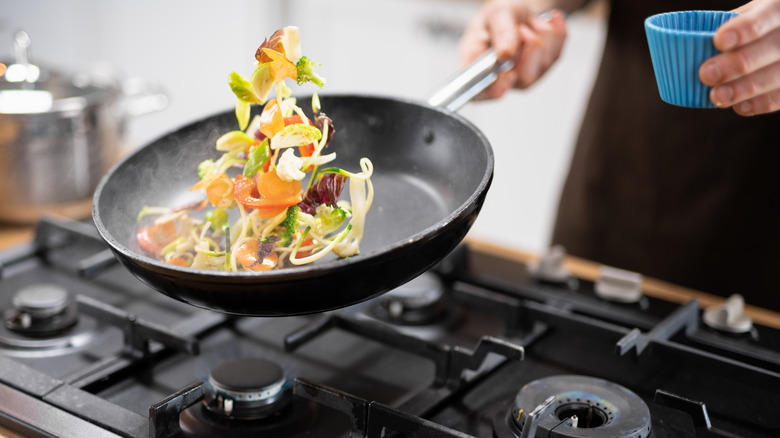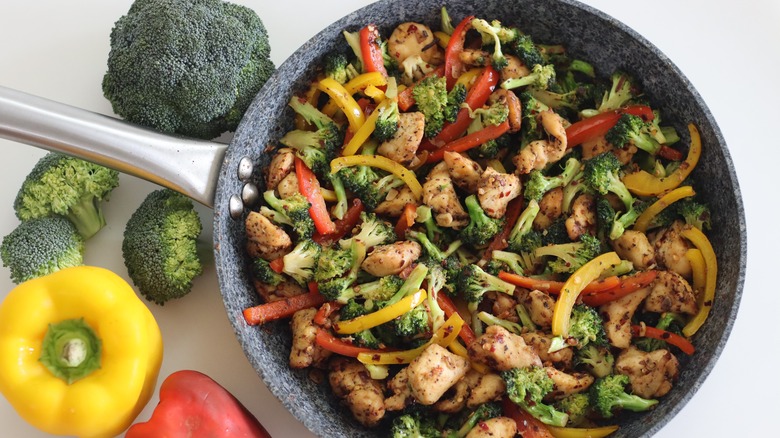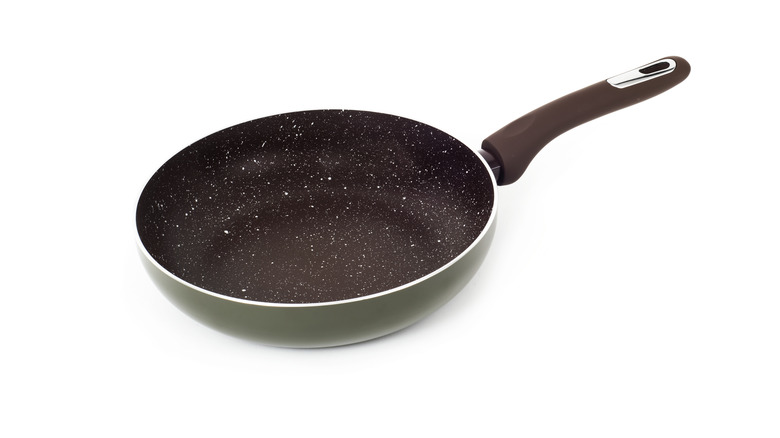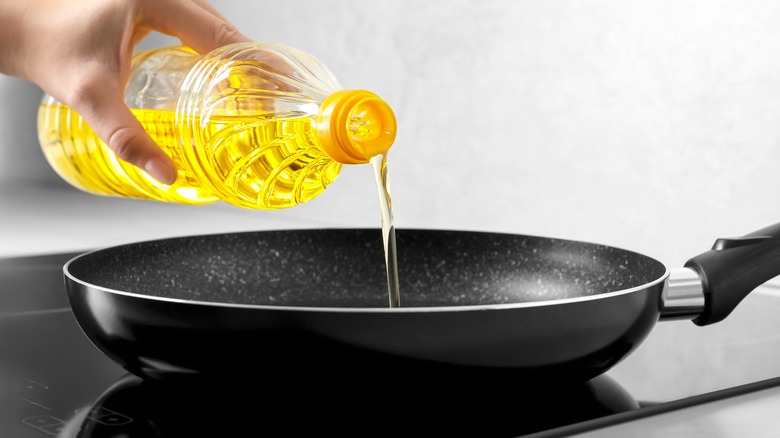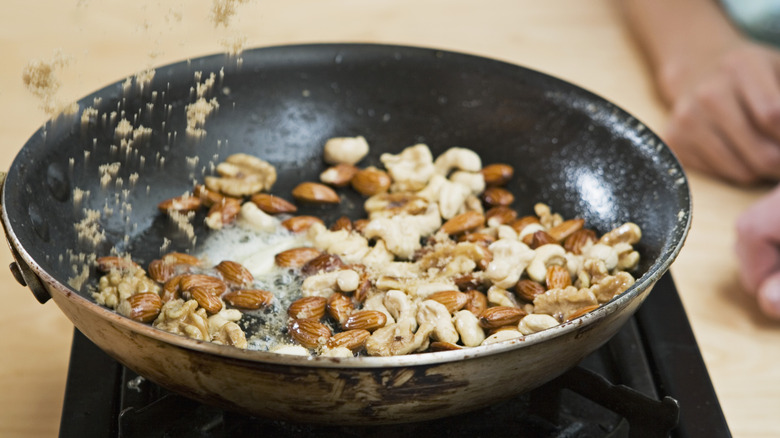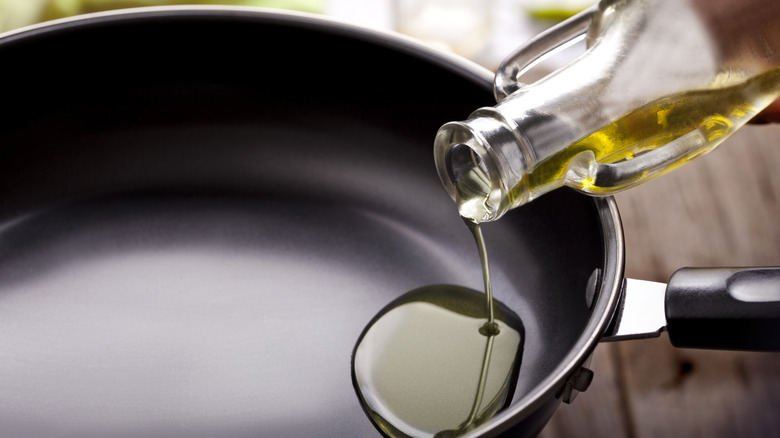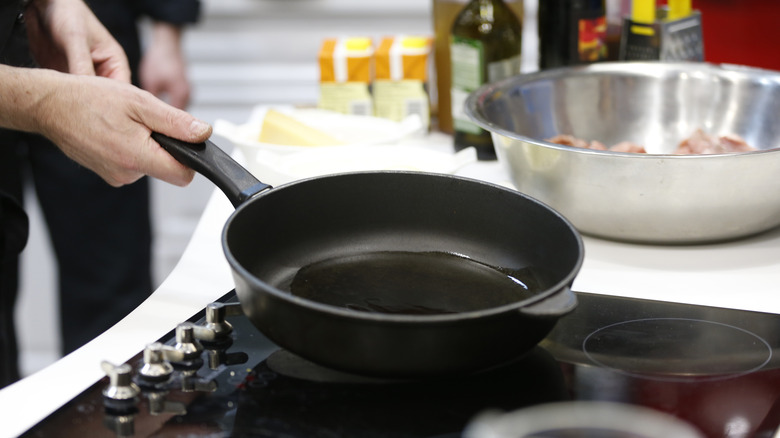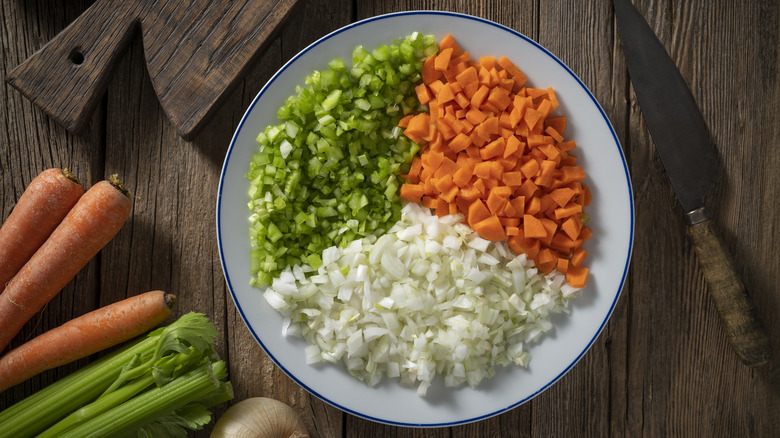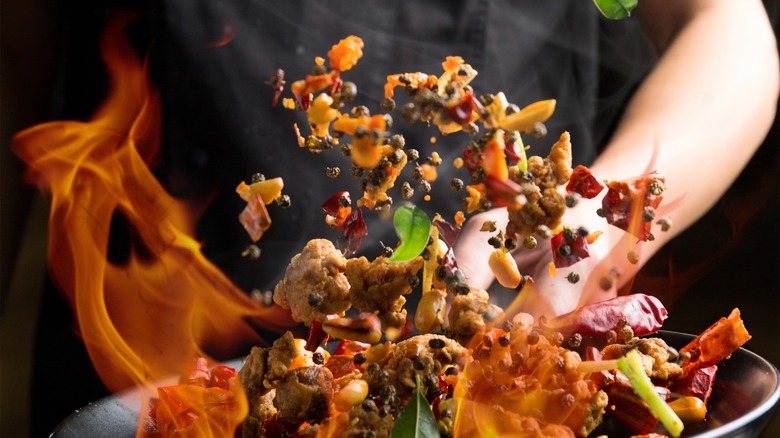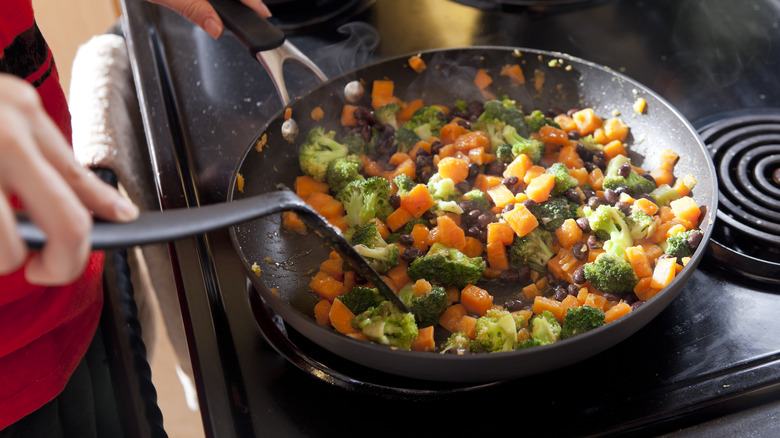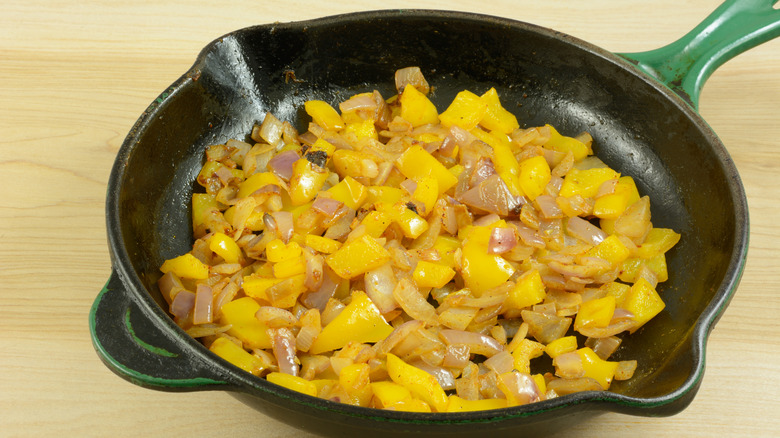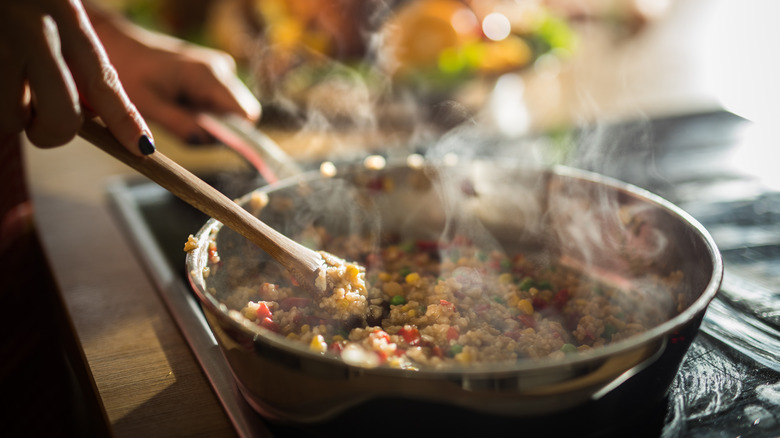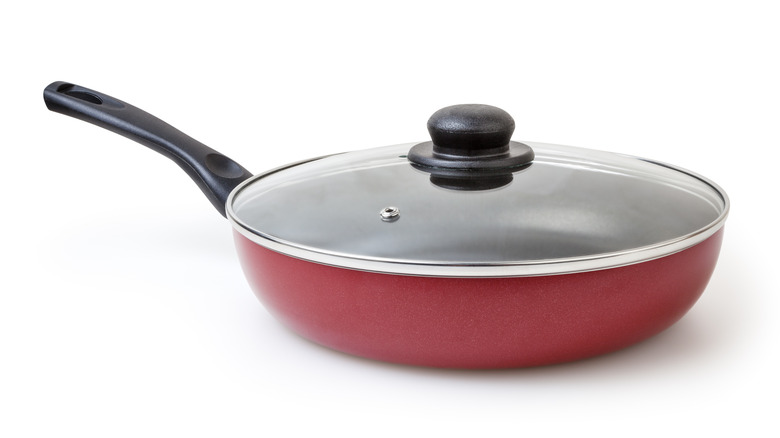12 Mistakes Everyone Makes When Sautéing
Perfecting the art of sautéing is a surefire way to elevate your cooking. This simple technique is a culinary building block, a foundational step in many recipes that, when done correctly, produces perfectly cooked food. Recipes ranging from soups to casseroles start with sautéing vegetables and aromatics to build layers of flavor in your dish. If you've ever added chopped onion and garlic to a pan lightly coated in olive oil and cooked them until they soften and brown, you've sautéed.
Sautéing is crucial in cooking all types of cuisine, and it's often one of the first skills on the syllabus of most culinary school curriculums. By definition, sautéing is cooking food in a large, shallow pan over relatively high heat in a small amount of oil. Sautés typically have a short cooking time and require occasional, not constant, stirring or flipping. The goal is vegetables that are crisp-tender and small cuts of meat or poultry that are perfectly browned on the outside and fully cooked and moist inside.
As simple as a sauté can be, there are common missteps cooks make that can ruin the process. You can make every sauté a success by avoiding these mistakes people make when sautéing.
Choosing the wrong food to sauté
Sautéing is a valuable cooking technique for a wide variety of foods, but it's not the best cooking method for everything. The quick cooking time associated with sautéing means it should be used for meats and vegetables that cook relatively quickly. Chopped vegetables like onion, carrot, and celery that make up a traditional mirepoix, the flavor base for numerous recipes, are excellent choices. Sautéing those vegetables is often the first step in many recipes. Vegetables like chopped bell peppers, garlic, mushrooms, green beans, zucchini, and asparagus are also perfect for sautéing because they cook quickly and thoroughly. You can sauté denser vegetables like potatoes, sweet potato, rutabaga, turnips, and parsnips, but they should be roasted or parboiled before sautéing to ensure they cook thoroughly.
Meat and poultry should be cut before sautéing. Thinly sliced pieces, like the cuts used for schnitzel or scallopini, can be sautéed successfully. Cutting meat and poultry into bite-sized pieces makes them good candidates for sautéing. Larger cuts of meat should be avoided when sautéing. While they might brown nicely when added to a hot pan with a bit of oil, they won't cook fully. Choose meats that are tender when cooked quickly, like chicken breasts or thighs. Tougher cuts of meat require a longer cooking time and usually a liquid to tenderize them.
Using a small pan
Choosing the right pan will improve your chances of sautéing success. Selecting a shallow pan large enough to hold all of the ingredients you're working with is important. Crowding a small pan will prevent your food from browning properly and negatively affect the texture. Your pan should have a heavy bottom, which will help it conduct heat evenly so that your food cooks evenly. Look for materials like aluminum, stainless steel, or cast iron, all of which are excellent conductors of heat, for best results.
Sauté pans and skillets are often used interchangeably, but there are substantial differences. To sauté properly, you probably won't use a sauté pan at all, but a large shallow pan with low, sloped, or curved sides. Most cookware manufacturers call this type of pan a skillet, while the pans named sauté pans have straight sides. The curved sides make it easier to carefully toss the food in the pan.
A shallow pan makes it easier for excess moisture to evaporate away during cooking. Too much moisture will cause the excess liquid to pool in the bottom of the pan, so your food will end up stewing in its own juices instead of sautéing.
Sautéing with low smoke point oils
Choosing the right oil is another way to ensure your success when you're sautéing. Oils come in several varieties, and all oils aren't the right choice for every cooking technique. Selecting the best oil for the job means paying attention to its smoke point.
Smoke point is the temperature at which a cooking oil begins to break down and produce smoke. When oils reach this temperature, they also start to lose some of their nutritional benefits. Typically, the darker in color an oil is, the lower its smoke point, meaning first-press extra virgin olive oils, with their deep, green hues, are not traditionally the best choices for high-heat cooking. The USDA recently updated its guidelines and now recommends some high-quality olive oils for high-heat cooking, like sautéing.
Neutral oils like vegetable, canola, grapeseed, avocado, and coconut oil are more refined than olive oil. They have higher smoke points, making them excellent options for sautéing. These oils are considered neutral oils because they don't have intense flavors that will transfer to the food you're cooking. Neutral oils are usually lighter in color. You'll want to avoid low-smoke point oils when sautéing is on the menu.
Starting with a cold pan
Impatience is never a good thing, especially in the kitchen. When you're hurrying to get dinner on the table, it might seem like no big deal to put a pan on the stove and immediately start adding food to get a head start on cooking. This shortcut might save you time, but it will undoubtedly prevent you from achieving the perfect sauté.
When you're cooking food in the oven, most recipes direct you to preheat the oven to the desired temperature so that your cookies, cakes, meats, and vegetables cook correctly. Preheating your pan when you're sautéing is essential so that your sautéed foods cook thoroughly and evenly.
Your pan should be nice and hot so that adding food should give you a nice, loud sizzle. If you add food to a pan and don't hear a sizzle, take the food out and try again when the pan has had more time to reach a higher temperature. A good sizzle means the pan is hot enough to do its job: cook the food so that it eventually begins to brown as it cooks. Starting with a cold pan will leave you with food that is off in texture and color.
Using too much or too little oil
Oil is an essential player in cooking, particularly when you're sautéing. It's not only critical to choose the best oil for the job; you also need to make sure you get the amount right because too much or too little can ruin your recipe. Adding too much oil to your pan when you're sautéing can lead to disaster, and before you know it, your simple side of sautéed vegetables has turned into a deep fry.
The amount of oil required to sauté will vary depending on the pan size you're using, but it's essential to ensure the pan's bottom is evenly coated with a thin layer of oil. The oil will keep the food from sticking to the bottom of the pan and help the food cook evenly. Pay close attention to the pan as you cook to ensure you don't need to adjust the amount of oil in your pan.
Too little oil can also be a problem. If your food is sticking to the pan or burning, add oil as needed while you cook. Fatty ingredients, like bacon, will render their oil as they cook, so start with less oil and add more if necessary.
Adding ingredients to cold oil
Preheating the oil in a pan before adding food is equally as crucial as preheating the pan itself, so resist the temptation to skip it. As with all things sautéed, preserving the fully cooked, moist interior and the browned, crispy exterior that sautéing can create is the goal. Hot oil in a hot pan causes the food, when it's added, to immediately develop a thin outer crust. This crust seals in the juices to maintain moisture, and hot oil causes the food to brown. The food cooks by coming into contact with the bottom of the pan, but the hot oil also conducts heat and helps cook the food evenly.
In addition to serving as a conductor of heat, hot oil in a pan serves another purpose. When food is added to a pan with cold or lukewarm oil, instead of developing a beautifully browned exterior, it absorbs all of the oil in the pan. The result is food with a less-than-perfect texture and uneven browning. Both your proteins and vegetables will lose their texture, becoming a soggy, oily mess.
Chopping food in uneven sizes
Knife skills can make your life in the kitchen much more manageable. When you're comfortable with your knife and know how to chop, dice, and slice with ease, not only is prep work easier, but you'll likely be able to produce better food with this one fundamental trick.
When you assemble your mise en place, the ingredients you'll need to prepare a recipe, chop all the ingredients you want to cook into pieces about the same size because size matters when you're sautéing. No matter the recipe or the ingredients you're cooking with, those cut into uniform pieces will perform better in your pan.
When ingredients are chopped uniformly, they will likely cook at about the same time, so you will never end up with large pieces that are undercooked and blended in with small, overcooked pieces. This uniformity of size also lends itself to more even cooking and browning. This is particularly important when cooking meat and poultry. Uneven pieces may lead to large pieces not reaching the proper internal temperature, creating an environment where bacteria can multiply and grow. Similarly sized ingredients are also easier to move around the pan whether you're stirring them or tossing them in the pan.
Using wet ingredients
Water is typically your friend in the kitchen, but it can ruin sautéed meat, poultry, and vegetables. Taking the time to gently pat food dry before adding it to a hot pan will protect your food from the harm water can cause.
Sautéing is done at a relatively high temperature in a pan coated with oil. Oil and water don't mix, and adding heat to the equation is a bad idea. The water on the food will spatter when it hits the hot oil, creating a burn risk and making a mess as you cook. The moisture will also inhibit the Maillard reaction in the pan. The Maillard reaction is the magic that happens in a pan when food is cooked. The hot pan and oil create a reaction in the raw ingredients that causes a flavorful change, creating flavor where there was none. For the Maillard reaction to take place, all food needs to be dry when added to the pan.
When water is heated, steam is created, even in a sauté pan. Not drying food off before adding it to a sauté pan can cause food to steam instead of sauté. Steamed food does not brown, and the moisture in the pan will keep the food from getting crispy.
Adding ingredients in the wrong order
Sautéing correctly is more than just tossing ingredients into a hot pan. Depending on the ingredients you're cooking with, the order in which you add the ingredients to the pan can influence the outcome of your dish. Adding them in the proper order ensures that each ingredient is cooked to perfection with maximum flavor and the best texture.
Both vegetables and meat and poultry all have different cooking times. Adding them all to the pan simultaneously will mean the ingredients that cook quickly risk being overcooked, while ingredients that require a longer cooking time will end up raw or undercooked. Both of these scenarios can create a dangerous situation in the kitchen.
To prevent this, add the ingredients to the hot pan according to the time they need to cook properly. Ingredients that take longer to cook, like meat, poultry, carrots, and dense vegetables, should hit the pan first to give them ample time to cook. Depending on the size of your protein, you may be able to add it after the vegetables have softened a bit. Smaller pieces of protein will cook quickly, and adding them to the pan after the vegetables allow them to absorb the layers of flavor created by the sautéed vegetables.
Crowding the pan
Crowd control is an often overlooked aspect of sautéing. Crowding a small pan will prevent your food from browning properly and negatively affect the texture and taste. Adding food to a pan, even a hot pan, causes the pan's temperature to drop. The temperature drops even further when you add more food than the pan can comfortably hold.
When the temperature drops, your food is no longer being sautéed. A warm pan will lead to an interruption of the browning that sautéed foods need and a drastic change in the texture of the food. Instead of crisp, moist, and deeply flavored, overcrowded pans lead to soft, stringy, water-logged foods. Protein added to a crowded pan is less likely to develop the outer crust that seals in juices.
Don't be afraid to cook your ingredients in batches so there's room to spread the food evenly across the bottom of the pan in a single layer instead of piling it high, which will create steam. Making sure the food has plenty of room to cook will give you beautiful food to look at that's also delicious to eat.
Moving the food too much
Stirring or turning food too much will interrupt cooking, prevent browning, and cause uneven cooking; stirring occasionally is the goal, but not constantly. When you're sautéing, stirring or turning the food in the pan is necessary to fully cook the food. Recipes often recommend stirring occasionally to direct cooks to move their food around in the pan periodically. This is done for two primary reasons.
First, stirring or tossing the food in the pan ensures that all sides of the food can come into contact with the bottom of the pan, which is how food is cooked. A periodic shake or stir will give you evenly cooked, beautifully browned food. Tossing or stirring the food in the pan also prevents the food from sticking to the bottom of the pan and burning.
However, it is possible to overdo it, which can also have negative results. Too much movement in the pan keeps the food from not just cooking properly but from cooking at all. Each stir, toss, or flip interrupts the cooking process. Stir too much, and your food will never brown or reach the desired temperature. Learn to add the food to the pan and give it time to cook through, stirring it occasionally to promote even cooking and prevent burning.
Covering the sauté pan
Covering the pan once the food's been added is one mistake that can ruin the outcome of your sauté. Sautéing is a dry heat cooking method, meaning no liquid is added to the food or the pan. The food is cooked to perfection by the combination of the hot pan and your hot cooking oil of choice. When you cover the pan, several things happen, all of which will ruin your dish.
When a hot pan gets hot, it produces steam. When you cover that pan, the steam cannot evaporate, which is what happens when pans are left uncovered. Instead, the steam hits the inside of the lid, where it condenses, turning back into water that then drips from the lid directly onto the food in the pan. That excess water will change the texture of your food, prevent browning, and cause steam to build up inside the pan. The steam will also soften the food.
The intense heat that builds up from sautéing can easily overcook the food. The lid makes it hard to monitor what's happening in your pan. Has the oil been absorbed? Is the bottom of the pan dry? Has the food been overcooked? These are just a few questions you'll have if you top a sauté pan with a lid.
